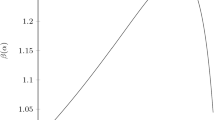Abstract
Distribution-free newsvendor models often assume continuous demand distributions to facilitate analysis and computation. However, in practice, discrete demand is a natural phenomenon. So far, there exists no analytical and computational results in the literature under this setting. Thus, the goal of this paper is to investigate the newsvendor problems with partial information when the demand is discrete and solve them using the so-called discrete moment problems. Numerical results are presented to illustrate the value of discrete information.

Similar content being viewed by others
References
Alizadeh, F., & Goldfarb, D. (2003). Second-order cone programming. Mathematical Programming, 95(1), 3–51.
Andersson, J., Jörnsten, K., Nonås, S. L., Sandal, L., & Ubøe, J. (2013). A maximum entropy approach to the newsvendor problem with partial information. European Journal of Operational Research, 228(1), 190–200.
Axsäter, S. (2013). When is it feasible to model low discrete demand by a normal distribution? OR spectrum, 35(1), 153–162.
Courtois, C., & Denuit, M. (2009). Moment bounds on discrete expected stop-loss transforms, with applications. Methodology and Computing in Applied Probability, 11(3), 307–338.
Gallego, G., & Moon, I. (1993). The distribution free newsboy problem: Review and extensions. Journal of the Operational Research Society, 44(8), 825–834.
Kumaran, V., & Swarnalatha, R. (2017). Bounds for the probability of union of events following monotonic distribution. Discrete Applied Mathematics, 223, 98–119.
Lemke, C. E. (1954). The dual method of solving linear programming problem. Naval Research Logistics Quarterly, 1(1), 36–47.
Mádi-Nagy, G., & Prékopa, A. (2004). On multivariate discrete moment problems and their applications to bounding expectations and probabilities. Mathematics of Operations Research, 29(2), 229–258.
Mádi-Nagy, G. (2008). On multivariate discrete moment problems: Generalization of the bivariate min algorithm for higher dimensions. SIAM Journal on Optimization, 19(4), 1781–1806.
Mádi-Nagy, G. (2012). Polynomial bases on the numerical solution of the multivariate discrete moment problem. Annals of Operations Research, 200(1), 75–92.
Natarajan, K., Sim, M., & Uichanco, J. (2018). Asymmetry and ambiguity in newsvendor models. Management Science, 64(7), 2973–3468.
Ninh, A., & Prékopa, A. (2013). The discrete moment problem with fractional moments. Operations Research Letters, 41(6), 715–718.
Ninh, A., & Prékopa, A. (2015). Log-concavity of compound distributions with applications in stochastic optimization. Discrete Applied Mathematics, 161(18), 3017–3027.
Ninh, A., & Pham, M. (2018). Logconcavity, twice-logconcavity and Turán-type inequalities. Annals of Operations Research,. https://doi.org/10.1007/s10479-018-2923-y.
Perakis, G., & Guillaume, R. (2008). Regret in the newsvendor model with partial information. Operations Research, 56(1), 188–203.
Prékopa, A. (1988). Boole-Bonferroni inequalities and linear programming. Operations Research, 36(1), 145–162.
Prékopa, A. (1990a). Sharp bounds on probabilities using linear programming. Operations Research, 38(2), 227–239.
Prékopa, A. (1990b). The discrete moment problem and linear programming. Discrete Applied Mathematics, 27(3), 235–254.
Prékopa, A. (1990c). Totally positive linear programming problems. In L. J. Leifmann (Ed.), Functional analysis, optimization and mathematical economics. A collection of papers dedicated to the memory of L. V. Kantorovich (pp. 197–207). New York: Oxford University Press.
Prékopa, A. (1992). Inequalities on expectations based on the knowledge of multivariate moments. Lecture Notes-Monograph Series, 309–331.
Prékopa, A. (1995). Stochastic Programming. Dordrecht: Kluwer Scientific.
Prékopa, A. (1998). Bounds on probabilities and expectations using multivariate moments of discrete distributions. Studia Scientiarum Mathematicarum Hungarica, 34(1), 349–378.
Prékopa, A. (2001). Discrete higher order convex functions and their applications. In N. Hadjisavvas, J. E. Martínez-Legaz, J. P. Penot (Eds.), Generalized Convexity and Generalized Monotonicity. Lecture Notes in Economics and Mathematical Systems (Vol. 502). Berlin, Heidelberg: Springer.
Prékopa, A. (2009). Inequalities for discrete higher order convex functions. Journal of Mathematical Inequalities, 3(4), 485–498.
Prékopa, A., Ninh, A., & Alexe, G. (2016). On the relationship between the discrete and continuous bounding moment problems and their numerical solutions. Annals of Operations Research, 238(1–2), 521–75.
Prékopa, A., Subasi, M., & Subasi, E. (2008). Sharp bounds for the probability of the union of events under unimodality condition. European Journal of Pure and Applied Mathematics, 1(1), 60–81.
Scarf, H. (1958). A min-max solution of an inventory problem. In Studies in the Mathematical Theory of Inventory and Production. Stanford University Press.
Subasi, E., Subasi, M., & Prékopa, A. (2009). Discrete moment problems with distributions known to be unimodal. Mathematical Inequalities and Applications, 12(3), 587–610.
Swaminathan, J. M., & Shanthikumar, J. G. (1999). Supplier diversification: Effect of discrete demand. Operations Research Letters, 24(5), 213–221.
Swarnalatha, R., & Kumaran, V. (2017). Bounds for the probability of the union of events with unimodality. Annals of Operations Research,. https://doi.org/10.1007/s10479-017-2629-6.
Acknowledgements
The authors would like to thank the referees for the constructive comments and discussions that led to this improved version of the paper.
Author information
Authors and Affiliations
Corresponding author
Rights and permissions
About this article
Cite this article
Ninh, A., Hu, H. & Allen, D. Robust newsvendor problems: effect of discrete demands. Ann Oper Res 275, 607–621 (2019). https://doi.org/10.1007/s10479-018-3016-7
Published:
Issue Date:
DOI: https://doi.org/10.1007/s10479-018-3016-7




